View in other NatureServe Network Field Guides
NatureServe
Montana
Utah
Wyoming
Idaho
Wisconsin
British Columbia
South Carolina
Yukon
California
New York
Didymo Diatom - Didymosphenia geminata
Other Names:
Rock Snot
General Description
Morphological Category - Asymmetric biraphid.
A large, robust, bottle-shaped diatom with capitate apices.
Axial area narrow, linear.
Central area rounded.
Raphe lateral; proximal ends bulbous, deflected slightly towards stigmata; distal fissures hooked towards side away from stigmata.
Striae composed of prominent areolae, radiate, becoming parallel towards the apices.
Size RangeLength 65–160 µm.
Width 35–40 µm.
Striae in 10 µm 7–9.
Stigmata 2–5.
Useful Link:
Diatom Glossary [Diatoms of North America website]
Diagnostic Characteristics
Distinguished in the field by the golden-brown, felt-like mats and under the microscope by the large, robust, bottle-shaped valves and translucent stalks.
Didymosphenia is more closely related to the cymbelloid genus
Cymbella, especially
Cymbella mexicana and
Cymbella janischii, than to other gomphonemoid (bottle-shaped) genera (e.g.,
Gomphoneis and
Gomphonema).
Range Comments
Native and widely distributed in the northern hemisphere, mainly in the mountains. Didymosphenia geminata is the only species within the genus that has been documented in the lower 48 states.
MONTANA
Didymosphenia geminata was first reported for Montana at Flathead Lake in 1929 by C.J. Elmore (Prescott and Dillard 1979). However, other historical recordings date its occurrence in Montana to the year 1866 (Coyle 2015 and Coyle 2016).
In a study examining the distribution and abundance of Didymosphenia geminata in and near Glacier National Park in Montana, periphyton samples taken from 1976 through 2007 were examined (Bahls 2007). Didymosphenia geminata was present in 36 of the 46 (78%) samples representing many locations in the North Fork and Middle Fork of the Flathead River dating back to 1976. Of theses samples 35 were collected in flowing and 1 from standing waters. In 2007, 68 samples contained Didymosphenia geminata, of which 30 (73%) samples were from flowing water and 6 (22%) samples were from standing water. Also in 2007, large populations of more than 200 valves were found in each of Park’s major drainage basins: Atlantic, Pacific, and Hudson Bay.
Observations in Montana Natural Heritage Program Database
Number of Observations: 616
(Click on the following maps and charts to see full sized version)
Map Help and Descriptions
Relative Density
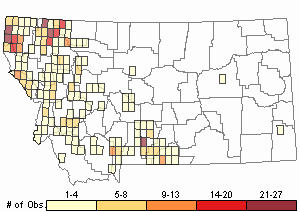
Recency
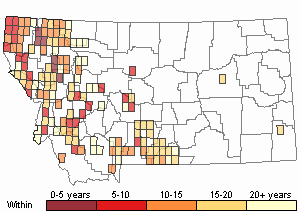
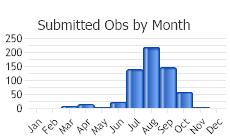
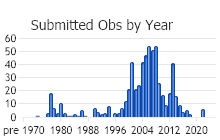
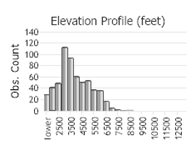 (Observations spanning multiple months or years are excluded from time charts)
(Observations spanning multiple months or years are excluded from time charts)
Habitat
Didymo is found in benthos of rivers and creeks and wash zones of lake shores.
In Glacier National Park Didymo has predominately been found in flowing waters with fewer occurrences in standing water based on samples taken from 1976 to 2007 (Bahls 2007; see Range Comments section). Sites that supported substantial numbers in 2007 were exposed to openings within the forest canopy, of which several locations were in flowing waters below waterfalls or lake outlets. Sites that supported small numbers were found at higher elevation creeks.
Ecology
Cells attach to stream bottoms by polysaccharide stalks, forming thick, golden-brown, felt-like mats. In older colonies, stalks may grow up to 1 meter in length and cells become detached, leaving just the white stalks. Mats typically persist for a short period of time, but under changing conditions can become large and persistent (see Management section).
WATER CHEMISTRY
Cool, alkaline, low-nutrient waters with low to moderate conductivity. Abundance-weighted means: pH = 8.3; conductivity = 144 µS/cm; temperature = 10.2 degrees Celsius.
MACROINVERTEBRATES
Where colonies develop large and thick mats, there can be a decrease in the density of large-bodied macroinvertebrates, particularly Mayflies (Ephemeroptera), Stoneflies (Plectoptera), and Caddisflies (Trichoptera), and an increase in small-bodied taxa such as Midges (Chironomidae) (Coyle 2015).
Reproductive Characteristics
Diatoms typically reproduce by cell division (mitosis) and occasionally by meiosis—sexual reproduction in which female and male gametes combine to form a specialized zygote called an auxospore. Repeated divisions result in cells of a population becoming progressively smaller and smaller. When cells reach a critically small size, sexual reproduction is initiated, resulting in an auxospore and initial cells that are the largest attainable for the species, after which cell division and size reduction resume (Amato 2010).
Stewardship Responsibility
Threats or Limiting Factors
Conservation:
There is a misconception that Didymo is inherently invasive in streams (Coyle 2015; Bothwell et al. 2014; Taylor and Bothwell 2014). Research is demonstrating that the development of large mats is not a sign of ‘invasion’ as much as a signal that water quality in the water body is changing (Coyle 2015). Nuisance mats are defined as mats that extend more than 1 kilometer and persist for several months of the year (Spaulding and Elwell 2007). Unlike algal responses, Didymo forms nuisance mats during winter in cold rivers with low nutrient concentrations, high light availability, and stable rock (Coyle 2015; Bothwell et al. 2014; see Habitat section). These conditions occur below dams in the tailwaters of impounded streams, at lake outlets, along lake shores that have significant wave action, or in other similar microhabitats. Research on the Kootenai River in Montana have found nitrogen concentrations increasing since about 2006 as a result of upstream anthropogenic activities in the watershed (Coyle 2015). Downstream of Libby Dam on the Kootenai River, extensive mats have been found extending for 32 miles below the dam with patchy mats occurring for another 49 miles downstream and persisting for 10 months out of the year. Where mat coverage is the greatest, the average soluble reactive phosphorus (SRP) concentration was found to be below the detectable measure of 0.5 ug/L while the combined nitrate/nitrite concentrations were greater than 200 ug/L.
Colonies may become a nuisance and impair aesthetics and habitat for fish and other aquatic life (Schweiger et al. 2011). Large blooms of Didymo can create thick mats, making stream substrates more slippery. Large mats can snag fishing gear and alter the community of macroinvertebrates (Coyle 2015; see Ecology section).
Didymo may be a potential indicator of thermal and hydrological modifications associated with climate warming, particularly in fairly pristine ecosystems, such as in portions of Glacier National Park (Schweiger et al. 2011). In Glacier National Park, Didymo is anticipated to increase in abundance as a response to global warming and reduced stream flows while Distrionella incognita is expected to decrease in abundance; both of which could serve as indicators of environmental change (Bahls 2007).
Didymo is native in the USA, but is considered invasive in New Zealand and South America.
In Canada persistent nuisance mats were reported in 1989 on Vancouver Island and associated with popular fishing areas (Cothwell et al. 2009). Research found that Didymo could remain viable on damp, felt-soled waders indicating that fisherman could disperse this diatom (Kilroy et al. 2007). The development and persistence of mats seems to be linked more with site conditions and water quality (Coyle 2015; Bahls 2007).
References
- Literature Cited AboveLegend:
 View Online Publication
View Online Publication Amato, A. 2010. Diatom reproductive biology: living in a crystal cage. The International Journal of Plant Reproductive Biology 2(1): 1-10.
Amato, A. 2010. Diatom reproductive biology: living in a crystal cage. The International Journal of Plant Reproductive Biology 2(1): 1-10. Bahls, L. 2007. Diatom indicators of climate change in Glacier National Park. Intermountain Journal of Sciences 13(4):99–109.
Bahls, L. 2007. Diatom indicators of climate change in Glacier National Park. Intermountain Journal of Sciences 13(4):99–109. Blanco, S. and L. Ector. 2009. Distribution, ecology and nuisance effects of the freshwater invasive diatom Didymosphenia geminata (Lyngbye) M. Schmidt: a literature review. Nova Hedwigia 88(3-4):347–422.
Blanco, S. and L. Ector. 2009. Distribution, ecology and nuisance effects of the freshwater invasive diatom Didymosphenia geminata (Lyngbye) M. Schmidt: a literature review. Nova Hedwigia 88(3-4):347–422. Bothwell, M., B. Taylor, and C. Kilroy. 2014. The Didymo Story: The Role of Low Dissolved Phosphorus in the Formation of Didymosphenia geminata blooms.
Bothwell, M., B. Taylor, and C. Kilroy. 2014. The Didymo Story: The Role of Low Dissolved Phosphorus in the Formation of Didymosphenia geminata blooms. Bothwell, ML, DL Lynch, H. Wright, and J. Deniseger. 2009. On the boots of fishermen: the history of Didymo blooms on Vancouver Island, British Columbia. Fisheries. Volume 34, pages 382-388.
Bothwell, ML, DL Lynch, H. Wright, and J. Deniseger. 2009. On the boots of fishermen: the history of Didymo blooms on Vancouver Island, British Columbia. Fisheries. Volume 34, pages 382-388. Coyle, M.K., 2016. Didymosphenia geminata in the Kootenai River in Libby, Montana: nuisance mat characteristics and management strategies for suppression. Ph.D. Dissertation. University of Idaho. 180 p.
Coyle, M.K., 2016. Didymosphenia geminata in the Kootenai River in Libby, Montana: nuisance mat characteristics and management strategies for suppression. Ph.D. Dissertation. University of Idaho. 180 p. Coyle, Mary Katie. 2015. Your Ugly Algae Neighbor: Rock Snot, A Naive Nuisance. Summer. Student Corner, NALMS-Lakeline.
Coyle, Mary Katie. 2015. Your Ugly Algae Neighbor: Rock Snot, A Naive Nuisance. Summer. Student Corner, NALMS-Lakeline. Diatoms of North America: Didymosphenia geminata. Accessed 25 September 2019. https://diatoms.org/species/didymosphenia_geminata
Diatoms of North America: Didymosphenia geminata. Accessed 25 September 2019. https://diatoms.org/species/didymosphenia_geminata Kilroy, C., A. Lagerstedt, A. Davey, and K. Robinson. 2007. Studies on the survivability of the invasive diatom Didymosphenia geminata under a range of environmental and chemical conditions. Natl. Inst. Of Water and Atmos. Res. Christchurch, New Zealand.
Kilroy, C., A. Lagerstedt, A. Davey, and K. Robinson. 2007. Studies on the survivability of the invasive diatom Didymosphenia geminata under a range of environmental and chemical conditions. Natl. Inst. Of Water and Atmos. Res. Christchurch, New Zealand. Kociolek, J.P. and E.F. Stoermer. 1988. A preliminary investigation of the phylogenetic relationships among the freshwater, apical porefield-bearing cymbelloid and gomphonemoid diatoms (Bacillariophyceae). Journal of Phycology 24:377–385.
Kociolek, J.P. and E.F. Stoermer. 1988. A preliminary investigation of the phylogenetic relationships among the freshwater, apical porefield-bearing cymbelloid and gomphonemoid diatoms (Bacillariophyceae). Journal of Phycology 24:377–385. Kumar, S., S. Spaulding, T. Stohlgren, K. Hermann, T. Schmidt and L. Bahls. 2009. Modelling the bioclimatic profile of the diatom Didymosphenia geminata. Frontiers in Ecology and the Environment 8:415-420.
Kumar, S., S. Spaulding, T. Stohlgren, K. Hermann, T. Schmidt and L. Bahls. 2009. Modelling the bioclimatic profile of the diatom Didymosphenia geminata. Frontiers in Ecology and the Environment 8:415-420. Montana Diatom Collection. 1968-Present. The Montana Diatom Collection at The University of Montana Herbarium (MONTU). Giovanna Bishop, Curator and Collections Manager, MONTU, University of Montana, Missoula, Montana.
Montana Diatom Collection. 1968-Present. The Montana Diatom Collection at The University of Montana Herbarium (MONTU). Giovanna Bishop, Curator and Collections Manager, MONTU, University of Montana, Missoula, Montana. Schweiger, E.W., I.W. Ashton, C.C. Muhlfeld, L.A. Jones, and L.L. Bahls. 2011. The distribution and abundance of a nuisance native alga, Didymosphenia geminata, in streams of Glacier National Park—climate drivers and management implications. Park Science 28(2):88–91.
Schweiger, E.W., I.W. Ashton, C.C. Muhlfeld, L.A. Jones, and L.L. Bahls. 2011. The distribution and abundance of a nuisance native alga, Didymosphenia geminata, in streams of Glacier National Park—climate drivers and management implications. Park Science 28(2):88–91. Spaulding, S., and L. Elwell. 2007. Increase in nuisance blooms and geographic expansion of the freshwater diatom Didymosphenia geminata. U.S Geological Survey Open File Report.
Spaulding, S., and L. Elwell. 2007. Increase in nuisance blooms and geographic expansion of the freshwater diatom Didymosphenia geminata. U.S Geological Survey Open File Report. Spaulding, S., C. Kilroy, and M. Edlund. 2010. Diatoms as invasive species. pp. 560-569 In J. Smol and E.F. Stoermer (eds). The Diatoms: Applications for the Environmental and Earth Sciences. Cambridge, UK: Cambridge University Press. 667 p.
Spaulding, S., C. Kilroy, and M. Edlund. 2010. Diatoms as invasive species. pp. 560-569 In J. Smol and E.F. Stoermer (eds). The Diatoms: Applications for the Environmental and Earth Sciences. Cambridge, UK: Cambridge University Press. 667 p. Spaulding, S.A., I.W. Bishop, M.B. Edlund, S. Lee, P. Furey, E. Jovanovska, and M. Potapova. 2019-Present. Diatoms of North America. Available at: https://diatoms.org.
Spaulding, S.A., I.W. Bishop, M.B. Edlund, S. Lee, P. Furey, E. Jovanovska, and M. Potapova. 2019-Present. Diatoms of North America. Available at: https://diatoms.org. Taylor, B.W. and M.L. Bothwell. 2014. The origin of invasive microorganisms matters for science, policy and management: The case of Didymoshenia geminata. Bioscience. 64(6): 531-538.
Taylor, B.W. and M.L. Bothwell. 2014. The origin of invasive microorganisms matters for science, policy and management: The case of Didymoshenia geminata. Bioscience. 64(6): 531-538.
- Additional ReferencesLegend:
 View Online Publication
View Online Publication
Do you know of a citation we're missing? Sylvester, R. and B. Stephens. 2011. Evaluation of the physical and biological effects of the Northwest Power Conservation Council's Mainstem Amendment upstream and downstream of Libby Dam, Montana. Libby, MT: Montana Fish, Wildlife, and Parks Annual Report prepared for U.S. Department of Energy Bonneville Power Administration. Bonneville Power Administration Project No. 2006-008-00, Contract Nos. 43309 and 48555. 282 p.
Sylvester, R. and B. Stephens. 2011. Evaluation of the physical and biological effects of the Northwest Power Conservation Council's Mainstem Amendment upstream and downstream of Libby Dam, Montana. Libby, MT: Montana Fish, Wildlife, and Parks Annual Report prepared for U.S. Department of Energy Bonneville Power Administration. Bonneville Power Administration Project No. 2006-008-00, Contract Nos. 43309 and 48555. 282 p. Sylvester, R. and B. Stephens. 2012. Evaluation of the physical and biological effects of the Northwest Power Conservation Council's Mainstem Amendment upstream and downstream of Libby Dam, Montana. Libby, MT: Montana Fish, Wildlife, and Parks Annual Report prepared for U.S. Department of Energy Bonneville Power Administration. Bonneville Power Administration Project No. 2006-008-00, Contract Nos. 48555 and 53910. 358 p.
Sylvester, R. and B. Stephens. 2012. Evaluation of the physical and biological effects of the Northwest Power Conservation Council's Mainstem Amendment upstream and downstream of Libby Dam, Montana. Libby, MT: Montana Fish, Wildlife, and Parks Annual Report prepared for U.S. Department of Energy Bonneville Power Administration. Bonneville Power Administration Project No. 2006-008-00, Contract Nos. 48555 and 53910. 358 p. Sylvester, R.M., B.C. Stephens, and J.T. Frye. 2014. Mainstem Columbia Amendments Research at Libby Dam - Evaluation of the Physical and Biological Effects of the Northwest Power Conservation Council's Mainstem Amendment Upstream and Downstream of Libby Dam, Montana. Libby, MT: Montana Fish, Wildlife, and Parks Annual Report prepared for U.S. Department of Energy Bonneville Power Administration. Bonneville Power Administration Project No. 2006-008-00. 461 p.
Sylvester, R.M., B.C. Stephens, and J.T. Frye. 2014. Mainstem Columbia Amendments Research at Libby Dam - Evaluation of the Physical and Biological Effects of the Northwest Power Conservation Council's Mainstem Amendment Upstream and Downstream of Libby Dam, Montana. Libby, MT: Montana Fish, Wildlife, and Parks Annual Report prepared for U.S. Department of Energy Bonneville Power Administration. Bonneville Power Administration Project No. 2006-008-00. 461 p.
- Web Search Engines for Articles on "Didymo Diatom"





